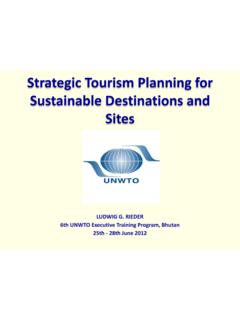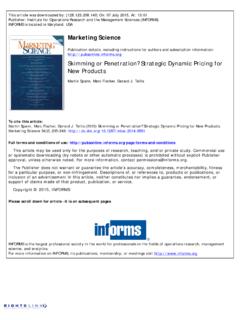Transcription of Organisational Capability and their strategic impact on ...
1 International Journal of Scientific and research Publications, Volume 4, Issue 12, December 2014 1. ISSN 2250-3153. Organisational Capability and their strategic impact on firms Market Share Brahmane Jayant Shaligram National Institute of Industrial Engineering (NITIE), Mumbai Abstract-The focus of this paper is to theoretically investigate about different Organisational capabilities. Understanding about the Organisational Capability can support organisation to draft strategies and invest directly to the capabilities which has better outcome in terms of business performance. This study focuses on organizational capabilities such as innovation, supply chain management, manufacturingR&D,and marketing and their effect on organizational performance with strategic capabilities show their presence through Organisational processes and are source of competitive advantage. The focus of research is to investigate about marketing Capability and associate its relevance in B2B model of organizational Capability and market share as business performance outcome proposed in the paper is one of the useful platform to understand dynamic Capability and implementation of Capability to solve business bottlenecks.
2 Paper focuses on theoretically conceptualizing and creating platform for research scholars for further extension of this research in the form of empirical study. It would also be useful for managers to benchmark their marketing strategies. Index Terms- Organisational Capability , market share, changing environment, strategy I. INTRODUCTION. arket based organizational learning has been identified as an important source of sustainable competitive advantage (Vorhies M and Morgan 2005). Market driven business units developed higher level of six vital marketing capabilities (in the area of market research , pricing, product development, channels, promotions and market management) than their less market driven rival business units on the four measures of organizational performance viz. growth, profitability, customer satisfaction and adaptability (Vorhies, Harker, and Rao 1999).Companies with high adaptive Capability seemingly perform better than low adapters, despite the implication of high cost and inefficiency (Tracey, Lim, and Vonderembse 2005).
3 Short product life cycle in fashion retailing present number of marketing challenges for retail firms. In order to survive in this industry, it is vital for participant to develop and leverage core marketing capabilities (Moore and Fairhurst 2003). The most distinctive features of market-driven organizations are their mastery of the market sensing and customer linking capabilities (Day 1994).In order to understand capabilities, one needs also to understand the processes of interaction and inter organizational learning (Croom and Batchelor 1997). In recent year's management scholars sought to integration of resource based view and dynamic Capability approach within the field's epistemological orientation to provide normative framework for practicing managers (Pand a 2003b). Capabilities of a dynamic nature, aside from being a source of new resources for the company, provide a solid instrument for the organization's strategists.
4 These capabilities allow the activation and redirection of the complex framework of economic and organizational factors. Dynamic capabilities are key factors in optimizing the strategic course of the company's future (L pez 2005). As Managers become more responsible for their own strategic decision making, the clear understanding of enterprise's specific capabilities and advantages are required in order to achieve sustained competitive advantage (Benedetto and Song 2003). The core innovation assets (R & D, manufacturing and marketing) alone cannot lead to sustainable export growth. On the contrary, the supplementary innovation assets (learning, research , organizational resource allocation and strategy planning) not only enable the firm's technology assets to permeate into the entire competency integration, but also make it possible for firm to acquire sustainable international competitiveness (Guan and Ma 2003).
5 II. Organisational CAPABILITIES AND BUSINESS ENVIRONMENT. Capabilities can be sorted into three categories, depending on the orientation and focus of the defining processes. At one end of the spectrum are those that are deployed from the inside out and activated by market requirements, competitive challenges, and external opportunities. Examples are manufacturing and other transformation activities, logistics, and human resource management, including recruiting, training, and motivating employees. International Journal of Scientific and research Publications, Volume 4, Issue 12, December 2014 2. ISSN 2250-3153. Table I: Dynamic business environment and organizational Capability Dynamic Firms Action Firms Action Plan Focused External Area Authors Names Capability variables Self managing Day 1994. Rising Customer Improved teams, Manufacturing Guan and Ma 2003. Expectations Quality Focus ISO 9001:2000, Forker 1996.
6 TQM. Technology based Tracey, Lim, and Information performance and Reengineering Supply Chain Management Vonderembse 2005. Network productivity Tracey 2005. management Guan and Ma 2003. Software Learning Supply Chain Management, Service Weerawardena 2003. Augmentation Organisation Innovation Pandza 2003a Erosion of Expedictionary Innovation R&D Guan and Ma 2003. brands effort Speed, Moore and Fairhurst 2003. Marketing, Supply Chain Fashionisation Store image Breaking hierarchis Oktemgil and Management differentiation Greenley1997. Multiple Stakeholder oriented Marketing Greenley, Hooley and New constraints Stakeholders profile, Role of the Rudd 2004. board Transnational Marketing, Supply Chain Globalisation Think Global Day 1994. organisation Management, R&D. At the other end of the spectrum are those capabilities whose focal point is almost exclusively outside the organization. The purpose of these outside-in capabilities is to connect the processes that define the other organizational capabilities to the external environment and enable the business to compete by anticipating market requirements ahead of competitors and creating durable relationships with customers, channel members, and suppliers.
7 Finally, spanning capabilities are needed to integrate the inside-out and outside-in capabilities. Strategy development, new product/service development, price setting, purchasing, and customer order fulfillment are critical activities that must be informed by both external (outside-in) and internal (inside-out) analyses (Day1994). Focus on marketing capabilities in times of crisis may be less profitable than possessing the capabilities for strategic flexibility, especially as competitive intensity increases (Combe and Greenley 2004). Some studies found that market research capabilities and marketing management/planning capabilities are crucial to the success of market-driven businesses (Day 1994; Vorhies, Harker, and Rao1999).Competition among firms is rising and to act proactively firm need to focus on their core competency. They need to focus on strategic alliance, marketing, supply chain management, manufacturing and R&D (Day 1994; Guan and Ma 2003; Tracey, Lim, and Vonderembse 2005 and Tracey 2005).
8 Major organizational capabilities have been categorised into different segments based on strategic aspects and changing environment. International Journal of Scientific and research Publications, Volume 4, Issue 12, December 2014 3. ISSN 2250-3153. III. CHANGING ENVIRONMENT AND Capability . Table 1 shows trends in dynamic external variables in changing environment and different strategy based action plan and Capability support which would be helpful for better performance of organization. While creating model dynamic Capability view is taken into account. shows model of organizational Capability and market share. Environmental changes are input while Capability based strategic solution is related to output which is business performance. The model takes into account customer satisfaction as a separate entity. IV. PERFORMANCE MEASURE. Companies need to identify and invest on developing different skill-sets which might produce same result which can be achieved by developing single skill-set.
9 Therefore, benchmarking is one of the important aspects of identifying and making use of Organisational capabilities. As per Vorhies and Morgan. (2005), marketing capabilities associated with superior business performance can be identified and that the marketingcapability gap between top-performing benchmarks and other firms explains significant variance in business performance. There are two views of organizational Capability . Some of the researchers state that organizational Capability lies in resource based view of corporate strategy and relates to the use of resources in the attainment of firm's strategic goals and objectives (O'Regan, and Ghobadian 2004). Resource based view approach does not adequately explain the process via which some firms reach position of competitive advantage in dynamic market or in situation of change. Dynamic Capability View approach evolved from resource approach helps in generation of firm's core competency (L pez 2005).
10 Significant potential business performance benefits can be available from successfully benchmarkingmarketingcapabilities. Market-based learning should include learning from competitors and peers. Market - oriented firms require strong marketingcapabilities (Day 1994; Vorhies and Morgan 2005). Market share has become a language for the expression of the market targets by top management. Clark (2000) found this dimension of most importance to managers. Since, by definition, changes in market share represent improving or declining performance relative to competitors, it inherently reflects the attainment or loss of competitive operationalisation of the "success of business'. products and programs in relation to those of its competitors in the market, measured by such items as sales growth in comparison with that of competitors or changes in market share" represents an effectiveness dimension of performance (Walker and Ruekert, 1987).














